
Forget baubles and tinsel. When iconic Japanese architect Kengo Kuma decided to design Christmas trees for the first time in his decades-long career, it was maybe no surprise that the material palette was simple, minimal and natural – crafted purely from wood. Kuma this week unveiled his two Christmas trees, each carefully designed to harmonise with their settings in two hotels he also designed: The Tokyo Edition, Toranomon and The Tokyo Edition, Ginza.
This being Kuma, these are no typical Christmas trees. The creations are made up of minimal curves and lines by skilled craftsmen from respected Japanese woodmakers Karimoku, in a medley of quality woods (oak, magnolia, walnut, maple) – and, in a sustainable festive twist, after Christmas, the trees will be dismantled and transformed into furniture.

At The Tokyo Edition, Toranomon, the tree is centre stage in the cloud-brushing 31st floor lobby. Here, among green leafy plants, minimalist wooden Kuma-designed eaves and sweeping skyscraper views, the 2.8m high tree – called Komorebi, a word referring to sunlight filtering through treetops – is made up of countless wooden circles.
These rings are connected by small hidden popper buttons so they can easily be attached, removed and arranged in an array of formations, in stacked units. Adding further depth, some rings are empty, while others contain discs of wood or mirrors, evoking a reflective sense of light, both during the day and after dark. Following its festive moment in the spotlight, this tree will be transformed into units of furniture – tables made up of a circular glass table-top, sitting on a trio of rings. One special table will be created from the rings that form the 'star' apex of the tree, which includes a trio of rings coated in gold.

The festive atmosphere shifts a short distance away at The Tokyo Edition, Ginza, where a very different tree called Kigumi – a word referring to nail-free Japanese joinery – sits in the hotel’s intimate dark walnut-panneled lobby on the ground floor.
This tree consists of countless thin vertical sticks in a variety of wood textures, with a scattering finished in silver and bronze metal paints, evoking a sharply elegant atmosphere. These components can be smoothly interlocked into tall thin stacks of three pieces of wood – which are then connected collectively to form a Christmas tree, with its angular lines echoing the weaving-like effect of the latticed façade of the hotel, also designed by Kuma.

The Ginza tree will also be dismantled and transformed into tables, with tall stacks of wood sitting beneath a circular tabletop of walnut. All the furniture will sell online, while two special tables made from with the apexes of the two trees will be sold via a silent auction.
Here, Kuma talks to Wallpaper* about his Christmas tree project – from its inspirations and craftsmanship to its wooden material palette.
Kengo Kuma unwraps the creative inspiration behind his Christmas tree project

Wallpaper*: What’s the idea behind this project?
Kengo Kuma: Christmas trees are usually displayed indoors, but they can also be placed in the garden. In this project we interpreted the Edition hotels as the garden, and aimed to design a friendly space respectively, where people can relax with the tree as the main attraction.
W*: What connects the two tree designs in Ginza and Toranomon – and what differentiates them?
KK: In the Toranomon hotel, we used wood with sharp-edged designs in the architecture. To complement the sharpness of the design, we came up with a round, soft geometry for the tree. To the contrary, in Ginza, wood is used basically at 90 degrees in terms of the geometry, so we designed the tree with the pointed tip to add natural sharpness in the architecture.

W*: How did the idea of turning the trees into furniture come about and how will they be reborn?
KK: These Christmas trees won’t be thrown away after the event, but are to be dismantled and recycled as furniture, in order for them to live a much longer time. We wanted to use wooden materials so that people visiting there could feel the cycle of nature behind the Christmas trees.

W*: Can you tell me about your relationship with Karimoku – and the appeal of working together?
KK: Karimoku is a company who knows the nature of wood and has inherited a high-level of craftsmanship. We work with them often. The trees in this project required techniques to achieve great strength while using small and thin members. They did a wonderful job that could not be done by anyone else.
W*: Which woods were used?
KK: Oak from Tohoku, Sen from Hokkaido, Magnolia from Gifu, Japanese walnut from Tohoku, Itaya Maple from Hokkaido. And only for Ginza, walnut from North America.

W*: Can you explain the sustainability elements, in terms of both material and concept?
KK: In Japan, it has been a problem that tree plantations had been leaning toward coniferous trees, causing an imbalance with broadleaf trees that could affect the natural environment. We wanted to raise awareness by using broadleaf trees.

W*: Finally, what imprint do you hope these trees will leave on hotel visitors during the festive season and beyond?
KK: In addition to the trees, visitors would recognise wooden material is used throughout the interior of the two hotels – I would like them to be aware that wood is essential in our daily life, and extend their imagination further to the forests behind the trees.
https://www.editionhotels.com/tokyo-toranomon/festive/








